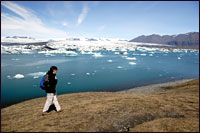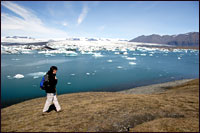Elizabeth Kolbert began building a fan base among political junkies with a series of vivid New Yorker profiles that were collected in 2004’s The Prophet of Love. Ranging from George Pataki and Hillary Clinton to Regis Philbin and Al Sharpton, from title character Rudy Giuliani to former Weatherman Kathy Boudin, Kolbert’s pieces were filled with telling details missing from her characters’ celebrity images.
She pulled no punches. Of my friend Mark Green’s mayoral primary win in New York City, she wrote, “Between the fawning and the gloating, the self-promotion and the perfunctory humility, victory celebrations are rarely tasteful affairs.” Still, I found myself developing empathy, and sometimes an unexpected trace of respect, for personalities I had blindly loved or loathed — mostly loathed — as distant caricatures. She made them human.
Kolbert has now done for climate disruption what she did for celebrities. She has taken a topic that many people think of as an impersonal collection of hurricanes, spreading deserts, and rising oceans — or perhaps as two lines crossing on a graph some decades from now — and given it a human face. And, as important, given it urgency.
Field Notes From a Catastrophe: Man, Nature, and Climate Change is an extraordinary piece of reporting. Like Kolbert’s earlier book, most of this one appeared first in the New Yorker. The author visits, among other locations, Alaska, Greenland, Yorkshire, and Oregon — places where people are studying, or simply experiencing, every facet of global warming.

Iceland: soon to be iceless?
Photo: iStockphoto.
Along the way, she hears about its impacts firsthand. She learns that Iceland is losing its ice: “We will have small ice caps on the highest mountains, but the mass of glaciers will have gone,” the head of the Icelandic Glaciological Society tells her. Iceland has had glaciers for at least two million years.
She visits Holland, where the government is beginning to buy out people who live on low-lying land that cannot be saved from rising seas. Holland is also experimenting with floating homes and considering buoyant highways. Bangladesh, by contrast, is simply suffering, and trying to cope with annual migrations much larger than that caused by Katrina.
Audio Excerpt
Hear actress Hope Davis read a section of Field Notes From a Catastrophe, from the Simon & Schuster audiobook.
Listen in Windows Media.
Listen in RealPlayer.
Kolbert gives even people with whom she disagrees ample opportunity to explain themselves, then deftly dissects their arguments. For example, she explains the origins of the Byrd-Hagel Resolution — adopted by the U.S. Senate 95-0 in 1997 — which said the United States should not comply with Kyoto until the developing world was similarly bound. She describes the formidable political forces that supported the resolution, from Exxon to the AFL-CIO, lucidly and fairly explaining the reasons behind their position.
Then she goes on: “From another perspective, however, the logic of Byrd-Hagel is deeply, even obscenely, self-serving. Suppose for a moment that the total anthropogenic CO2 that can be emitted into the atmosphere were a big ice-cream cake. If the aim is to keep global concentrations below 500 parts per million, then roughly half that cake has already been consumed, and, of that half, the lion’s share has been polished off by the industrialized world. To insist now that all countries cut their emissions simultaneously amounts to advocating that industrialized nations be allocated most of the remaining slices, on the ground that they’ve already gobbled up so much.”
Her three-sentence metaphor lays out with crystal clarity why the Byrd-Hagel response to Kyoto — and the Bush administration’s policy patterned on it — has made Americans so unpopular in so much of the world.
Field Notes works well as an introduction for those who will read just one book on climate, as it deftly weaves in the evolution of the underlying theory and the startling annual accumulation of greenhouse gases measured by the U.S. Weather Bureau at Mauna Loa since 1958. But it is also a wonderful read for those of us who follow the literature pretty closely.
What Kolbert does best is explain things through conversations with experts. These scientists, most of them obscure outside their disciplines but superstars to their peers, are the nameless people behind the reports by the Intergovernmental Panel on Climate Change, the National Academy of Sciences, NASA’s Goddard Institute, and others. Kolbert brings them alive, describes their oddball peculiarities and scientific achievements, and has them describe what they’ve learned in terms that she — no policy wonk — can understand and convey to the reader. I’ve read most of their reports, but the cumulative impact of their casual conversations is much more frightening than their carefully calibrated journal articles — and that’s saying something.
Rob Socolow, codirector of Princeton’s Carbon Mitigation Initiative, deftly summarizes the central theme of the book: “I’ve been involved in a number of fields where there’s a lay opinion and a scientific opinion,” he told Kolbert. “And in most cases it’s the lay community that is more exercised, more anxious … But in the climate case, the experts — the people who work with climate models every day, the people who do ice cores — they are more concerned. They are going out of their way to say, ‘Wake up!'”
Elizabeth Kolbert allows them to say “Wake up!” to an audience they would otherwise never reach. For the sake of the planet, I hope that audience, especially in America, is enormous — and that it includes all the political wonks who loved her first book so much.



